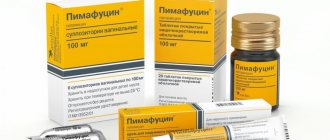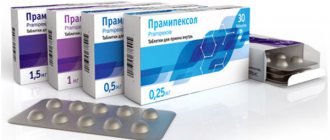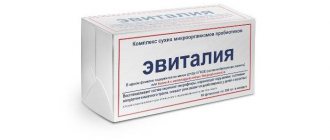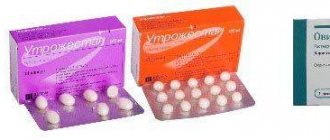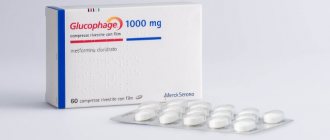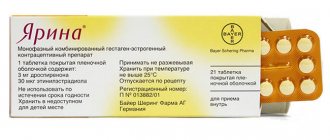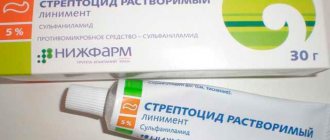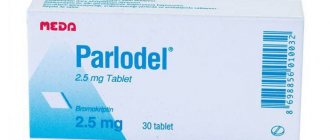Release form and composition
Dosage form - tablets: almost white or white, slightly biconvex, with a chamfer: round in dosage 2 and 8 mg or oval in dosage 4 mg, on one side of the 4 and 8 mg tablets there is a separating line (in blister packs 10 pcs., in a cardboard box of 3, 6 or 9 packs; in blister packs of 14 pcs., in a cardboard box 1, 2, 4 or 7 packs; in blister packs of 30 pcs., in a cardboard box 1, 2 or 3 packs).
Composition of 1 tablet:
- perindopril erbumine, semi-finished granules – 38.39/76.78/153.56 mg;
- active substance semi-finished granule – perindopril erbumine – 2/4/8 mg;
- auxiliary components of semi-finished granules: calcium chloride hexahydrate, lactose monohydrate, crospovidone;
- excipients of tablets: colloidal silicon dioxide, microcrystalline cellulose, magnesium stearate.
Perineva price
The cost of tablets in Russia, depending on the packaging, is 220 rubles (4 mg), 330 rubles (8 mg). In Ukraine, the price of 8 mg is 180 UAH, 4 mg is 130 UAH.
- Online pharmacies in RussiaRussia
ZdravCity
- Perineva tablets 4 mg 90 pcs. Krka-Rus LLC
641 rub. order - KO-Perineva tablets 8mg+2.5mg 90 pcs. Krka-Rus LLC
RUB 1,058 order
- KO-Perineva tablets 8mg+2.5mg 30 pcs. Krka-Rus LLC
RUR 549 order
- KO-Perineva tablets 2mg+0.625mg 30 pcs. Krka-Rus LLC
RUB 306 order
- KO-Perineva tablets 4mg+1.25mg 30 pcs. Krka-Rus LLC
472 RUR order
Pharmacological properties
Pharmacodynamics
Perindopril or kinase II is an angiotensin-converting enzyme (ACE) inhibitor, belongs to exopeptidases and is a prodrug from which the active metabolite perindoprilat is formed. Converts angiotensin I to angiotensin II (vasoconstrictor) and destroys the vasodilator bradykinin to an inactive hectapeptide. Due to the suppression of ACE activity, the level of angiotensin II decreases, plasma renin activity increases (negative feedback of renin release is inhibited) and aldosterone secretion decreases. ACE destroys bradykinin, so suppression of this enzyme also leads to an increase in the activity of the circulating and tissue kallikrein-kinin system, while activating the prostaglandin system.
The therapeutic effect of the drug is due to the effect of the active metabolite – perindoprilate.
Perindopril lowers blood pressure (both diastolic and systolic) in the lying and standing positions. It reduces total peripheral vascular resistance (TPVR), as a result of which blood pressure (BP) decreases. At the same time, peripheral blood flow accelerates, but the heart rate (HR) does not increase. As a rule, renal blood flow also accelerates, but the glomerular filtration rate does not change. It takes 4–6 hours for the maximum hypotensive effect to develop after a single oral dose; the effect persists for 24 hours, but even after 24 hours, 87–100% of the maximum effect is still provided. Blood pressure decreases quickly. Stabilization of the hypotensive effect is observed after 1 month of regular use of Perineva and persists for a long time. Discontinuation of therapy does not cause the development of withdrawal syndrome.
The active substance reduces myocardial hypertrophy of the left ventricle. Increases the concentration of high-density lipoproteins (HDL); in patients with hyperuricemia, reduces the concentration of uric acid. With long-term use, it normalizes the myosin isoenzyme profile and reduces the severity of interstitial fibrosis.
The drug eliminates structural changes in small arteries and improves the elasticity of large arteries. By reducing pre- and post-load, it normalizes heart function. In chronic heart failure (CHF), it reduces peripheral vascular resistance, filling pressure in the right and left ventricles, increases cardiac output and cardiac index. When taking the drug in an initial daily dose of 2 mg in patients with CHF functional classes I and II according to the NYHA classification, there is no statistically significant decrease in blood pressure compared to placebo.
Pharmacokinetics
Perindopril in tablet form is rapidly absorbed from the gastrointestinal tract; it takes 1 hour to achieve maximum plasma concentration. Bioavailability is about 65–70%.
About 20% of the absorbed substance is converted into the active metabolite perindoprilat. The maximum content in plasma is observed after 3–4 hours. Half-life (T1/2) – 1 hour. The volume of distribution of unbound perindoprilate is 0.2 l/kg. The connection with blood plasma proteins is insignificant, the connection with ACE is less than 30%, but depends on its concentration. Excreted by the kidneys. Does not accumulate. T1/2 of the unbound fraction is 3–5 hours; in patients with chronic heart and renal failure and the elderly, excretion is slow.
In patients with liver cirrhosis, the hepatic clearance of perindopril changes, but the total amount of metabolite formed remains unchanged, so dose adjustment of Perineva is not required.
Food reduces the conversion of perindopril to perindoprilat, thereby reducing the bioavailability of the drug.
Perindoprilat is removed by peritoneal dialysis and hemodialysis (rate 70 ml/min., 1.17 ml/sec.).
Answers to frequently asked questions
Answers to current customer questions are provided.
- What is the difference between Perineva or Perindopril?
The two medications contain the same active substance – perindopril. They differ in manufacturer, auxiliary components, bioavailability (efficacy), and quality. When replacing, you should choose proven analogues.
- Is Perineva a diuretic or not?
The drug contains perindopril and belongs to the group of antihypertensive drugs (ACE inhibitors). Does not have a diuretic effect.
Indications for use
According to the instructions, Perineva is intended for the treatment of arterial hypertension and chronic heart failure.
The drug is used (as part of complex therapy with indapamide) to prevent recurrent stroke in patients with a history of cerebrovascular diseases.
An ACE inhibitor is also prescribed for stable coronary heart disease (CHD) to reduce the risk of cardiovascular complications in patients who have undergone coronary revascularization and/or myocardial infarction.
Prestarium or Perineva – which is better?
Prestarium A is an original drug based on perindopril. Available in two dosages - 5 and 10 mg and two forms - regular tablets and soluble in the mouth. The dispersible form is convenient for people who find it inconvenient to drink water (for example, they are unable to do so at work) and have difficulty swallowing. The price for 30 tablets is more expensive than Perineva.
When choosing between Prestarium and Perineva, given financial capabilities, the first medicine is recommended. It is original, which means it has been clinically studied in patients with arterial hypertension, stable angina, and those who have suffered myocardial infarction and stroke.
When taking Prestarium, according to reviews from doctors and patients, cough and bronchospasm occur less frequently as a side effect.
Contraindications
Absolute contraindications (conditions/diseases for which the drug is prohibited from taking):
- age under 18 years;
- Lapp lactase deficiency, hereditary galactose intolerance, glucose-galactose malabsorption syndrome;
- history of idiopathic, hereditary, or angioedema resulting from taking ACE inhibitors;
- increased individual sensitivity to any component of the drug or other ACE inhibitors.
Relative contraindications (conditions/diseases in which the use of the drug is possible, but only after assessing the benefits and risks, with extreme caution and under special medical supervision):
- CHF in the stage of decompensation;
- arterial hypotension;
- hypertrophic obstructive cardiomyopathy;
- aortic or mitral valve stenosis;
- renovascular hypertension;
- cerebrovascular diseases (including coronary heart disease, cerebrovascular insufficiency, coronary insufficiency);
- chronic renal failure (creatinine clearance less than 60 ml/min);
- bilateral renal artery stenosis or stenosis of the artery of a single kidney;
- condition after kidney transplantation;
- hemodialysis using high-flow polyacrylonitrile membranes;
- the period before the low-density lipoprotein (LDL) apheresis procedure;
- severe hypovolemia and hyponatremia (for example, due to vomiting, diarrhea, salt-free diet, dialysis, previous diuretic therapy);
- hyperkalemia;
- congenital deficiency of glucose-6-phosphate dehydrogenase;
- connective tissue diseases such as systemic lupus erythematosus or scleroderma;
- diabetes;
- inhibition of bone marrow hematopoiesis due to the use of immunosuppressants, procainamide, allopurinol;
- surgical intervention;
- elderly age;
- belonging to the Negroid race;
- simultaneous desensitizing therapy with allergens (for example, hymenoptera venom).
Side effects and contraindications of Perinev
The drug Perineva has a number of contraindications, so before using the tablets, you should definitely consult with your doctor. List of conditions and diseases for which medication is not prescribed:
- individual intolerance to perindoprilate, as well as other components of the drug;
- glucose-galactose malabsorption;
- hypolactasia – lactose intolerance;
- history of angioedema due to treatment with angiotensin-converting enzyme inhibitors.
Perineva is not prescribed to children and adolescents under 18 years of age. The drug tends to penetrate the uteroplacental barrier, so it is not prescribed to pregnant women. If a woman is breastfeeding, it is recommended that the baby be switched to an adapted formula during treatment, and to maintain lactation, breast milk must be expressed and discarded.
The drug is prescribed with caution for aortic or mitral valve stenosis, severe hyponatremia, hemolytic anemia and diabetes mellitus.
In case of overdose, the patient may experience the following reactions:
- pronounced decrease in blood pressure;
- state of shock or collapse;
- increased potassium and decreased sodium in the blood;
- acute renal failure;
- frequent and intense breathing, leading to an imbalance of oxygen and carbon dioxide in the blood (this can lead to the development of dizziness, shortness of breath, weakness, and loss of consciousness);
- a sharp increase (up to 240 beats) or decrease (up to 30-50 beats) in heart rate;
- feeling of anxiety, coughing attack.
If the above symptoms develop during treatment with Perineva, the patient should urgently call an ambulance. Before the doctors arrive, the patient should be laid down, the window should be opened, and the top buttons on his clothes should be unbuttoned.
Reviews from doctors about Perinev are as follows: when used correctly (the accuracy of the diagnosis and the correct dosage are taken into account here), patients experience a stable decrease in blood pressure and ischemic attacks. However, doctors about - there is difficulty in selecting an individual dosage, so patients sometimes develop negative symptoms that are life-threatening.
Instructions for use of Perineva: method and dosage
It is advisable to take Perinev tablets before meals, once a day - in the morning.
The doctor selects the dose for the patient personally, based on the indication and individual effectiveness of treatment.
Regardless of the indications, the dosage can be increased only if the drug is well tolerated at the previous dose used.
Arterial hypertension
The drug is used either as monotherapy or as part of a combination treatment, in combination with other antihypertensive drugs.
The recommended starting dose of Perineva is 4 mg. For patients with pronounced activation of the RAAS (renin-angiotensin-aldosterone system), for example, with severe arterial hypertension, renovascular hypertension, decompensated CHF, hyponatremia, hypovolemia - 2 mg. If the effect is insufficient after a month of treatment, the daily dose can be increased to 8 mg.
If Perineva is prescribed to patients receiving diuretics, in order to avoid the development of arterial hypotension, it is recommended to start taking perindopril 2-3 days after stopping the diuretic or prescribe it at a minimum dose of 2 mg. In this case, the concentration of potassium ions in the blood serum, blood pressure and renal function should be monitored. Depending on the dynamics of blood pressure, the dose can be increased. Diuretic therapy is resumed if necessary.
Elderly patients are prescribed perindopril at a dose of 2 mg at the beginning of therapy. Further, according to indications, it is increased to 4 mg and, if the effect is still not enough, to 8 mg.
Prevention of recurrent stroke in patients with a history of cerebrovascular diseases
Perineva is taken at a dose of 2 mg 2 weeks before the appointment of indapamide.
You can start preventive therapy after a stroke at any time, even after several years, but not earlier than 2 weeks.
Chronic heart failure
The optimal starting dose is 2 mg. After 2 weeks, if necessary, under the control of blood pressure, it is increased to 4 mg. If the disease is accompanied by clinical manifestations, beta-blockers, potassium-sparing diuretics and/or digoxin are additionally prescribed.
In case of CHF, renal failure, a tendency to electrolyte disturbances (hyponatremia), or the simultaneous use of diuretics and/or vasodilators, treatment should be started under the strict supervision of a physician.
If there is a high risk of developing clinically significant arterial hypotension (for example, with concomitant use of a diuretic in high doses), it is recommended, if possible, to eliminate electrolyte disturbances and hypovolemia before prescribing Perineva. Before and during therapy, blood pressure, the concentration of potassium ions in the blood serum and the state of renal function should be constantly monitored.
Stable ischemic heart disease
The initial recommended daily dose of Perineva is 4 mg. After 2 weeks, under monitoring of renal function, the dose is increased to 8 mg.
Elderly patients begin to be treated with a dose of 2 mg. If the effect is insufficient, after mandatory preliminary monitoring of renal function, after a week it can be increased to 4 mg, and after another week - to 8 mg.
In case of renal failure, the dose is determined based on the results of a kidney function test, namely the creatinine clearance (CC):
- CC > 60 ml/min – 4 mg/day;
- CC 30–60 ml/min – 2 mg/day;
- CC 15–30 ml/min – 2 mg every other day;
- CC < 15 ml/min (hemodialysis) – 2 mg per day of dialysis.
During treatment, monitoring of the concentration of creatinine and potassium ions in the blood serum is required.
What can be combined with if necessary?
If there is such a request, then Perineva can be prescribed in combination with pharmaceuticals such as nitrates, beta-blockers, thrombolytics, as well as acetylsalicylic acid in doses with an antiplatelet effect.
Analogues of Perineva can be considered Coverex and Prestarium. It is also permissible to replace Perineva with Parnavel, Arentopres, Perindopril, Hypernik, Stopress, etc.
In pharmacies, the drug product is sold by prescription. The price of Perinev tablets is from 210 rubles for 30 pills/4 mg to 1000 rubles for 90 pills of 8 mg.
Side effects
Separation of side effects by prevalence: very often - > 1/10, often - from > 1/100 to < 1/10, infrequently - from > 1/1000 to < 1/100, rarely - from > 1/10000 to < 1 /1000, very rarely - <1/10000, including individual messages.
Side effects that may occur during perindopril therapy:
- from the organ of hearing: often – tinnitus;
- from the organ of vision: often – visual impairment;
- from the central and peripheral nervous system: often – paresthesia, headache, dizziness; uncommon – mood changes, sleep disturbances; very rarely - confusion;
- from the respiratory system: often – shortness of breath, cough; uncommon – bronchospasm; very rarely – rhinitis, eosinophilic pneumonia;
- from the musculoskeletal system: often – muscle cramps;
- from the genitourinary system: infrequently – impotence, renal failure; very rarely - acute renal failure;
- from the digestive tract: often - diarrhea, constipation, dyspepsia, abdominal pain, nausea, vomiting, dysgeusia; uncommon – dryness of the oral mucosa; rarely - pancreatitis; very rarely - hepatitis (cholestatic or cytolytic);
- from the cardiovascular system: often – marked decrease in blood pressure; very rarely - angina pectoris, arrhythmias, as well as stroke and myocardial infarction (in high-risk patients, possibly secondary, due to severe arterial hypotension); frequency unknown – vasculitis;
- from the hematopoietic organs and lymphatic system: very rarely in patients with congenital deficiency of glucose-6-phosphate dehydrogenase - hemolytic anemia; very rarely with long-term use of the drug in high doses - agranulocytosis, thrombocytopenia, pancytopenia, leukopenia/neutropenia, decreased hemoglobin concentration and hematocrit;
- from the skin: often – skin rashes, itching; uncommon – urticaria, angioedema of the face and extremities; very rarely - erythema multiforme;
- laboratory tests: hyperkalemia, increased concentrations of plasma creatinine and urea in the blood serum, especially in patients with severe CHF, renovascular hypertension and renal failure (reversible after discontinuation of the drug); rarely - hypoglycemia, increased bilirubin in the blood serum and liver enzyme activity;
- other reactions: often – asthenia; uncommon – increased sweating.
Co-Perineva tablet 1.25mg+4mg No. 90 79722
Description
Co-Perineva® KRKA (Slovenia) tablets 0.625 mg + 2 mg; blister 10, cardboard pack 9; No. LSR-004327/10, 2010-05-17 from KRKA (Slovenia); manufacturer: KRKA-Rus (Russia) Latin name Co-Perineva® Active ingredient Indapamide* + Perindopril* (Indapamidum + Perindoprilum) ATC: C09BA04 Perindopril in combination with diuretics Pharmacological group Combination antihypertensive drug (diuretic + angiotensin-converting enzyme inhibitor) [ACE inhibitors in combinations] Nosological classification (ICD-10) I10 Essential (primary) hypertension Description of the dosage form Tablets 0.625 mg + 2 mg: round, biconvex, white or almost white with a chamfer, a short line is engraved on one side. Tablets 1.25 mg + 4 mg: round, biconvex, white or almost white, scored on one side and chamfered. Tablets 2.5 mg + 8 mg: round, biconvex, white or almost white, scored on one side. Pharmacological action Pharmacological action - hypotensive, diuretic, vasodilator. Pharmacodynamics Co-Perineva® is a combination drug containing an ACE inhibitor - perindopril and a thiazide-like diuretic - indapamide. The drug has antihypertensive, diuretic and vasodilating effects. Co-Perineva® has a pronounced dose-dependent antihypertensive effect, independent of the patient’s age and body position and not accompanied by reflex tachycardia. Does not affect lipid metabolism (total cholesterol, LDL, VLDL, HDL, triglycerides (TG) and carbohydrates), incl. in patients with diabetes mellitus. Reduces the risk of hypokalemia caused by diuretic monotherapy. The antihypertensive effect lasts for 24 hours. A stable decrease in blood pressure is achieved within 1 month with the use of the drug Co-Perineva® without an increase in heart rate. Stopping treatment does not lead to the development of withdrawal syndrome. Perindopril is an ACE inhibitor, the mechanism of action of which is associated with inhibition of ACE activity, leading to a decrease in the formation of angiotensin II, eliminates the vasoconstrictor effect of angiotensin II, reduces the secretion of aldosterone. The use of perindopril does not lead to sodium and fluid retention and does not cause reflex tachycardia during long-term treatment. The antihypertensive effect of perindopril develops in patients with low or normal plasma renin activity. Perindopril acts through its main active metabolite, perindoprilate. Its other metabolites are inactive. The effect of the drug Co-Perineva® leads to: - dilation of veins (reduction of preload on the heart), caused by changes in PG metabolism; - reduction of peripheral vascular resistance (reduction of afterload on the heart). In patients with heart failure, perindopril helps to: - reduce the filling pressure of the left and right ventricles; - increase in cardiac output and cardiac index; - increasing regional blood flow in the muscles. Perindopril is effective for arterial hypertension of any severity: mild, moderate and severe. The maximum antihypertensive effect develops 4–6 hours after a single oral dose and persists throughout the day. Discontinuation of therapy does not lead to the development of withdrawal syndrome. It has vasodilating properties and restores the elasticity of large arteries. The addition of a thiazide-like diuretic enhances (addition) the antihypertensive effect of perindopril. Indapamide is a sulfonamide derivative and is a diuretic. Inhibits the reabsorption of sodium in the cortical segment of the renal tubules, increasing the excretion of sodium and chlorine by the kidneys, thus leading to increased diuresis. To a lesser extent increases the excretion of potassium and magnesium. Having the ability to selectively block “slow” calcium channels, indapamide increases the elasticity of arterial walls and reduces peripheral vascular resistance. It has a hypotensive effect in doses that do not have a pronounced diuretic effect. Increasing the dose of indapamide does not increase the antihypertensive effect, but increases the risk of adverse events. Indapamide in patients with arterial hypertension has no effect on lipid metabolism: TG, LDL and HDL and carbohydrate metabolism, even in patients with diabetes mellitus and arterial hypertension. Pharmacokinetics The combined use of perindopril and indapamide does not change their pharmacokinetic parameters compared to separate administration of these drugs. Perindopril after oral administration is rapidly absorbed from the gastrointestinal tract. Bioavailability is 65–70%. Eating reduces the conversion of perindopril to perindoprilat. T1/2 of perindopril from blood plasma is 1 hour. Cmax in blood plasma is achieved 3–4 hours after oral administration. Since taking with food reduces the conversion of perindopril to perindoprilat and the bioavailability of the drug, perindopril should be taken once a day in the morning, before breakfast. Taking perindopril once a day, equilibrium concentration is achieved within 4 days. It is metabolized in the liver to form an active metabolite - perindoprilate. In addition to the active metabolite perindoprilate, perindopril forms 5 more inactive metabolites. The binding of perindoprilate to plasma proteins is dose-dependent and amounts to 20%. Perindoprilat easily passes through histohematic barriers, excluding the blood-brain barrier; a small amount penetrates the placenta and into breast milk. Excreted by the kidneys, T1/2 of perindoprilate is about 17 hours. It does not accumulate. In elderly patients and in patients with renal and heart failure, the elimination of perindoprilate is slowed down. In case of renal failure, it is recommended to reduce the dose of perindopril depending on the severity of renal failure (creatinine clearance). The dialysis Cl of perindoprilate is 70 ml/min. The kinetics of perindopril is altered in patients with liver cirrhosis: hepatic clearance is reduced by half. However, the amount of perindoprilate formed does not decrease, which does not require dose adjustment. Indapamide. Quickly and almost completely absorbed into the gastrointestinal tract. Eating slightly slows down absorption, but does not significantly affect the amount of indapamide absorbed. Cmax in blood plasma is achieved 1 hour after oral administration of a single dose. Binds to plasma proteins by 79%. T1/2 ranges from 14 to 24 hours (average 18 hours). Does not accumulate. Metabolized in the liver. It is excreted by the kidneys (70%) mainly in the form of metabolites (the fraction of the unchanged drug is about 5%) and by the intestines with bile in the form of inactive metabolites (22%). In patients with renal failure, the pharmacokinetic parameters of indapamide do not change significantly. Indications for the drug Co-Perineva® Essential hypertension. Contraindications: hypersensitivity to the active substance, any ACE inhibitor, sulfonamide derivatives or any excipients of the drug; angioedema (hereditary, idiopathic or angioedema) while taking other ACE inhibitors (history); severe renal failure (creatinine Cl less than 30 ml/min); bilateral renal artery stenosis, stenosis of the artery of a single kidney; refractory hyperkalemia; lactose intolerance, lactase deficiency or glucose-galactose malabsorption; simultaneous use of drugs that prolong the QT interval on the ECG, simultaneous use with antiarrhythmic drugs that can cause ventricular tachycardia of the “pirouette” type (see “Interaction”); severe liver failure (including encephalopathy); pregnancy, breastfeeding, age under 18 years (efficacy and safety have not been established); Given the lack of sufficient experience with use, Co-Perineva® should not be taken by patients on dialysis and patients with untreated decompensated heart failure. With caution: systemic connective tissue diseases (including systemic lupus erythematosus (SLE), scleroderma), therapy with immunosuppressants (risk of developing neutropenia, agranulocytosis), inhibition of bone marrow hematopoiesis, decreased blood volume (taking diuretics, salt-free diet, vomiting, diarrhea) , angina pectoris, cerebrovascular diseases, renovascular hypertension, diabetes mellitus, chronic heart failure (functional class IV according to the NYHA classification), hyperuricemia (especially accompanied by gout and urate nephrolithiasis), blood pressure lability, elderly patients, hemodialysis using high-flow polyacrylonitrile membranes; before the LDL apheresis procedure, simultaneous desensitizing therapy with allergens (for example, hymenoptera venom); condition after kidney transplantation, stenosis of the aortic and/or mitral valve, hypertrophic obstructive cardiomyopathy. Use during pregnancy and breastfeeding Pregnancy. Taking Co-Perineva® is contraindicated during pregnancy. If you are planning pregnancy or if it occurs while taking Co-Perineva®, you should immediately stop taking the drug and prescribe other antihypertensive therapy. You should not use Co-Perineva® in the first trimester of pregnancy. There have been no controlled clinical studies on the use of ACE inhibitors in pregnant women. Limited data indicate that taking ACE inhibitors in the first trimester did not lead to fetotoxicity-related fetal malformations, but the fetotoxic effect of ACE inhibitors cannot be completely excluded. The drug Co-Perineva® is contraindicated in the second and third trimesters of pregnancy. Long-term use of ACE inhibitors in the second and third trimesters of pregnancy can lead to impaired fetal development (decreased renal function, oligohydramnios, delayed ossification of the skull bones) and the development of complications in the newborn (renal failure, arterial hypotension, hyperkalemia). Long-term use of thiazide diuretics in the third trimester of pregnancy can cause hypovolemia in the mother and a decrease in uteroplacental blood flow, which leads to fetoplacental ischemia and fetal growth retardation. In rare cases, while taking diuretics, hypoglycemia and thrombocytopenia may develop in the fetus/newborn. If a woman took an ACE inhibitor in the second and third trimesters of pregnancy, it is recommended to conduct an ultrasound of the kidneys and skull of the fetus/newborn. In newborns whose mothers received therapy with ACE inhibitors, hypotension may occur, so newborns should be under close medical supervision. Breastfeeding period. The drug Co-Perineva® is contraindicated during breastfeeding. It is not known whether perindopril is excreted in breast milk. Indapamide is excreted in breast milk. Causes a decrease or suppression of lactation. The newborn may develop hypersensitivity to sulfonamide derivatives, hypokalemia and nuclear jaundice. It is necessary to assess the significance of therapy for the mother and make a decision to stop breastfeeding or stop taking the drug. Side effects Perindopril has an inhibitory effect on the RAAS and reduces the excretion of potassium ions by the kidneys while taking indapamide. The risk of developing hypokalemia (serum potassium content less than 3.4 mmol/l) in patients using the drug Co-Perineva® at a daily dose of 0.625 mg/2 mg is 2%, 1.25 mg/4 mg - 4% and 2.5 mg/8 mg - 6%. WHO classification of the incidence of side effects: very often - ≥1/10; often - from ≥1/100 to <1/10; uncommon - from ≥1/1000 to <1/100; rarely - from ≥1/10000 to <1/1000; very rare - from <1/10000, frequency unknown - cannot be estimated based on available data. Within each group, adverse effects are presented in order of decreasing severity. From the hematopoietic organs: very rarely - thrombocytopenia, leukopenia/neutropenia, agranulocytosis, aplastic anemia, hemolytic anemia (there are reports with the use of ACE inhibitors). In certain clinical situations (conditions after kidney transplantation or in patients on hemodialysis or peritoneal dialysis), ACE inhibitors may cause anemia. From the central and peripheral nervous system: often - paresthesia, headache, dizziness, vertigo; infrequently - mood lability, sleep disturbances; very rarely - confusion. From the senses: often - visual impairment, tinnitus. From the cardiovascular system: often - a pronounced decrease in blood pressure, incl. orthostatic hypotension; very rarely - arrhythmias, incl. and bradycardia, ventricular tachycardia, atrial fibrillation, as well as angina pectoris, myocardial infarction, possibly secondary, due to a decrease in blood pressure in high-risk patients; frequency unknown - ventricular tachycardia of the “pirouette” type (possibly fatal). From the respiratory system: often - a dry cough that persists for a long time during the use of ACE inhibitors and disappears after their cessation; dyspnea; uncommon - bronchospasm; very rarely - eosinophilic pneumonia, rhinitis. From the digestive system: often - constipation, dryness of the oral mucosa, loss of appetite, nausea, epigastric pain, abdominal pain, impaired taste perception, vomiting, dyspepsia, diarrhea; very rarely - pancreatitis, angioedema of the intestine, jaundice; frequency has not been established - in case of liver failure, there is a possibility of developing hepatic encephalopathy. From the skin and subcutaneous fat: often - itching, skin rash, maculopapular rash; uncommon - angioedema of the face, extremities, lips, oral mucosa, tongue, vocal folds and/or larynx, urticaria; hypersensitivity reactions, mainly dermatological, in patients with a history of allergic reactions; worsening of SLE; very rarely - erythema multiforme, toxic epidermal necrolysis, Stevens-Johnson syndrome; isolated cases of photosensitivity reaction. From the musculoskeletal system: often - muscle spasms. From the urinary system: infrequently - renal failure; very rarely - acute renal failure. From the reproductive system: infrequently - impotence. Other: often - asthenia; infrequently - increased sweating. Laboratory indicators: rarely - hypercalcemia; frequency unknown - increase in QT on the ECG; increased concentrations of uric acid and glucose in the blood serum while taking the drug; increased activity of liver enzymes; a slight increase in plasma creatinine concentration, reversible after cessation of therapy, which often develops against the background of renal artery stenosis or stenosis of the artery of a single kidney, arterial hypertension during diuretic therapy, and renal failure; hypokalemia, especially significant for patients at risk; hypochloremia can lead to compensatory metabolic alkalosis (the likelihood and severity of the effect is low); hyperkalemia is often reversible; hyponatremia with hypovolemia, leading to a decrease in blood volume and orthostatic hypotension. According to clinical studies, side effects correspond to the previously established safety profile of the combination of perindopril and indapamide. In rare cases, the following serious adverse events have developed: hyperkalemia, acute renal failure, arterial hypotension and cough, and the possible development of angioedema. Interaction Simultaneous use of lithium preparations is not recommended. With the simultaneous use of lithium preparations and ACE inhibitors, cases of reversible increases in the concentration of lithium in the blood serum have been reported. Concomitant use of thiazide diuretics may increase the concentration of lithium in the blood plasma and the risk of its toxic effect while taking an ACE inhibitor. The simultaneous use of Co-Perineva® with lithium preparations is not recommended. If concurrent use is necessary, serum lithium concentrations should be carefully monitored. Concomitant use requiring special caution Baclofen - potentiation of the hypotensive effect. It is necessary to monitor blood pressure, renal function and, if necessary, adjust the dose of antihypertensive drugs. NSAIDs, incl. high doses of acetylsalicylic acid (more than 3 g/day). The simultaneous use of ACE inhibitors with NSAIDs (including acetylsalicylic acid in doses that have an anti-inflammatory effect, COX-2 inhibitors and non-selective NSAIDs) reduces the hypotensive effect of ACE inhibitors, increases the risk of developing renal dysfunction, including the development of acute renal failure, increases serum potassium levels blood, especially in patients with pre-existing renal impairment. This combination is recommended to be used with caution, especially in elderly patients. Before starting treatment, patients need to compensate for fluid loss, as well as regularly monitor kidney function both at the beginning of therapy and during treatment. Concomitant use requiring caution Tricyclic antidepressants, antipsychotics (neuroleptics). They enhance the hypotensive effect and increase the risk of developing orthostatic hypotension (additive effect). GCS, tetracosactide. Reducing the hypotensive effect (retention of fluid and sodium ions as a result of the action of corticosteroids). Other antihypertensive drugs: the hypotensive effect of Co-Perineva® may be enhanced. Perindopril Concomitant use is not recommended Potassium-sparing diuretics (spironolactone, triamterene, amiloride, eplerenone) and potassium supplements: ACE inhibitors reduce diuretic-induced renal potassium loss. When used together with ACE inhibitors, it is possible to increase the potassium content in the blood serum, including death. If simultaneous use of an ACE inhibitor and the above drugs is necessary (in case of confirmed hypokalemia), caution should be exercised and regular monitoring of potassium levels in the blood plasma and ECG parameters should be carried out. Simultaneous use, requiring special caution, hypoglycemic means for oral administration (sulfonyl grossing derivatives) and insulin: the use of ACE inhibitors (described for captopril and enalapril) in very rare cases can enhance the hypoglycemic effect of sulfonymic and insulin derivatives in patients with diabetes; With their simultaneous use, it is possible to increase glucose tolerance and a decrease in the need for insulin, which may require correction of doses of hypoglycemic agents for oral and insulin. Simultaneous use that requires caution of allopurinol, cytostatic immunosuppressants, GCS (with systemic use) and prokainamide: simultaneously taking these drugs with ACE inhibitors can increase the risk of leukopenia. Means for general anesthesia: ACE inhibitors can enhance the antihypertensive effect of certain means for general anesthesia. Diuretics (thiazide and loop): the use of diuretics in high doses can lead to hypovolemia (due to the reduction of BCC), and the addition of perindopril to a severe decrease in blood pressure to the therapy. Indapamide simultaneous use that requires special caution drugs that cause Ari: because There is a risk of hypokalemia, indapamide should be used with caution simultaneously with drugs that can cause ventricular tachycardia such as Piruet, such as: antiarrhythmic agents (quinidine, hydrochinidine, dysopiramid, amiodarone, prefhylaid, ibratille tozilate, Sotalol); some antipsychotics (chlorpromazine, cyamemazine, leftompromazine, thiooridase, trifluoperazin), benzamides (amisiprides, sulpiride, sultopride, tiapide), butyrophenons (Dropeidol, haloperidol), other neuroleptics (pimoside); Other drugs such as Bephilil, Cisapride, Dipemanne Methyl Sulfate, Erythromycin for use, halophantrin, mizolastin, moxifloxacin, pentamidin, sparfloxacin, vincamine for use, methadone, astemazole, terphenin. Simultaneous use with the above drugs should be avoided. It is necessary to control the content of potassium in the blood serum in order to avoid hypokalemia, with the development of which it is necessary to carry out its correction, to control the QT interval on the ECG. Medicines capable of causing hypokalemia: amphotericin in/in the introduction, glucose and mineralocorticoids (with systemic purpose), laxatives that stimulate intestinal motility (laxatives that do not stimulate intestinal motor skills), tetracosactide- an increase in the risk of hypocalymy ( additive effect). It is necessary to control potassium in blood plasma, if necessary, its correction. Particular attention should be paid to patients at the same time receiving cardiac glycosides. Cardiac glycosides: hypokalemia enhances the toxic effect of heart glycosides. With the simultaneous use of indapamide and cardiac glycosides, the potassium content in the blood plasma, ECG readings should be monitored and, if necessary, the dose of cardiac glycosides should be adjusted. Simultaneous use that requires caution metformin: functional renal failure against the background of diuretics, especially loop, while using metformin, increases the risk of lactic acid acidosis. Metformin should not be used if the concentration of creatinine in blood plasma exceeds 15 mg/l (135 μmol/l) - in men and 12 mg/l (110 μmol/l) - in women. Iodine -containing contrasting agents: in patients with hypovolemia against the background of diuretic agents there is an increased risk of developing acute renal failure, especially when using contrasting substances containing high doses of iodine. Before using iodine -containing contrast agents, BCC should be replenished. Calcium salts containing calcium salts: with simultaneous use, hypercalcemia is possible due to a decrease in calcium removal by kidneys. Cyclosporin: It is possible to increase the concentration of creatinine in blood plasma without changing the concentration of cyclosporine in blood plasma, even in the absence of a pronounced loss of sodium ions and dehydration. An overdose of symptoms: a pronounced decrease in blood pressure, nausea, vomiting, muscle cramps, dizziness, drowsiness, confusion, oliguria up to anuria (due to a decrease in BCC); Disorders of the water-electrolyte balance are possible (low sodium content
Possible product names
- Ko-Perineva tab. 1.25 mg+4 mg No. 90
- CO-PERINEVA 4 MG/1.25 MG TAB. No. 90
- CO-PERINEVA 0.00125+0.004 N90 TABLE
- KO-PERINEVA TABLE. (1.25 MG+4 MG) X90
- KO-PERINEVA TAB. 1.25 MG+4 MG No. 90
- CO-PERINEVA 1.25MG+4MG TAB. X90
- (Co-Perineva) Co-Perineva tab. 1.25 mg+4 mg No. 90
Overdose
Signs of overdose: marked decrease in blood pressure, bradycardia, palpitations, tachycardia, water and electrolyte imbalance (hyperkalemia, hyponatremia), hyperventilation, cough, anxiety, dizziness, renal failure, shock.
If there is a pronounced decrease in blood pressure, it is necessary to lay the patient down and elevate his legs, replenish the circulating blood volume (CBV), and, if possible, administer angiotensin II and/or a catecholamine solution intravenously. If bradycardia develops that is not amenable to drug therapy (including atropine), a pacemaker (artificial pacemaker) is installed. Treatment of overdose should be carried out under the monitoring of vital functions of the body, the concentration of creatinine and electrolytes in the blood serum. The drug can be removed from the systemic circulation by hemodialysis, but the use of high-flow polyacrylonitrile membranes should be avoided.
special instructions
Perineva is not recommended for use simultaneously with such drugs as lithium preparations, potassium preparations, potassium-sparing diuretics, potassium-containing nutritional supplements/products.
Like other ACE inhibitors, perindopril can cause a sharp decrease in blood pressure. Symptomatic hypotension after the first dose is rare in patients with uncomplicated hypertension. An excessive decrease in blood pressure is likely in individuals with reduced blood volume due to a strict salt-free diet, hemodialysis, diuretic therapy, vomiting and diarrhea, as well as with renin-dependent hypertension, severe CHF, including the concomitant presence of renal failure. More often, a pronounced decrease in blood pressure is observed in patients with severe CHF receiving high doses of loop diuretics, as well as in renal failure and hyponatremia. These categories of patients require careful monitoring at the beginning of treatment and during the selection of the optimal dose. The same applies to patients with coronary heart disease and cerebrovascular diseases, since an excessive decrease in blood pressure in them is fraught with myocardial infarction and cerebrovascular complications.
If the patient has arterial hypotension, it is necessary to place him in a horizontal position and raise his legs; if necessary, inject sodium chloride solution intravenously to increase the blood volume. Transient (passing) arterial hypotension is not a contraindication for continued treatment. After restoration of blood pressure and blood volume, therapy can be resumed, only it is necessary to select the correct dose of Perineva.
In some patients with CHF, including those with low blood pressure, the drug may cause an additional decrease in blood pressure. This effect is expected and is often not a reason to stop therapy. In cases where arterial hypotension is accompanied by clinical symptoms, reduce the dose of the drug or discontinue it completely.
If an episode (even a minor one) of unstable angina develops in patients with stable coronary heart disease during the first month of using Perineva, the benefit-risk ratio for further treatment should be assessed.
Patients with a history of angioedema not associated with ACE inhibitors are at high risk of angioedema as a reaction to perindopril.
If angioedema develops, Perineva must be discontinued immediately. For swelling of the lips and face, no special treatment is required; it is enough to take antihistamines to reduce the severity of symptoms. Swelling of the tongue, larynx, or glottis can lead to death. If such a reaction occurs, it is necessary to inject adrenaline (epinephrine) subcutaneously and ensure airway patency. More often, angioedema during therapy with ACE inhibitors occurs in patients of the Negroid race.
In rare cases, anaphylactic reactions develop in patients who undergo LDL apheresis using dextran sulfate absorption during treatment with Perineva; therefore, it is recommended to discontinue the ACE inhibitor before each procedure. The same applies to patients who are prescribed a course of desensitization - the drug should be temporarily discontinued before each procedure.
If during treatment there is an increase in the activity of liver enzymes or jaundice appears, the drug should be discontinued and appropriate examination carried out, since Perineva can cause the development of a syndrome starting with cholestatic jaundice and progressing to a fulminant course of hepatitis with extensive liver necrosis, even death.
ACE inhibitors may contribute to the development of renal failure and severe arterial hypotension in patients with renovascular hypertension, so treatment should be started with small doses, under close medical supervision and with further adequate titration of the drug dose. During the first weeks of taking Perineva, it is necessary to discontinue diuretics and constantly monitor renal function.
In some cases, in patients with arterial hypertension and previously undiagnosed renal failure, especially with concomitant use of diuretics, there may be a slight and temporary increase in creatinine and urea concentration in the blood serum, which requires a reduction in the dose of the drug and/or discontinuation of the diuretic.
Patients on hemodialysis should not use high-strength membranes for the session, otherwise persistent, life-threatening anaphylactic reactions may develop.
In patients with diabetes mellitus receiving insulin or taking oral hypoglycemic agents, blood glucose levels should be kept under control when initiating Perineva therapy.
Patients awaiting planned surgery or other procedures using anesthesia with drugs that can cause arterial hypotension should discontinue the ACE inhibitor one day before. If this is not possible, arterial hypotension can be corrected by increasing blood volume.
Perindopril may increase the concentration of potassium ions in the blood. The likelihood of developing hyperkalemia increases with renal and/or heart failure, decompensated diabetes mellitus, and in case of simultaneous use of potassium-sparing diuretics, potassium supplements or other drugs that can cause hyperkalemia (for example, heparin). If the combined use of these drugs is justified, the level of potassium in the blood serum should be constantly monitored.
When conducting a differential diagnosis of cough in a patient, it should be taken into account that perindopril can cause a persistent, non-productive cough - it stops after discontinuation of the drug.
Impact on the ability to drive vehicles and complex mechanisms
The drug can cause dizziness and arterial hypotension, which can affect reaction speed and concentration, which should be taken into account by drivers and people employed in potentially hazardous industries.
Who shouldn't drink
Perineva, as well as its analogues, has absolute and relative contraindications for use. For example, a categorical ban applies to children - this medication is not prescribed to persons under the age of majority in principle.
Among the absolute contraindications:
- Galactose intolerance and lactase deficiency, as well as glucose-galactose malabsorption syndrome;
- High individual sensitivity to formula ingredients or other representatives of this pharmaceutical group;
- Idiopathic nature of angioedema earlier.
With such diagnoses or characteristics, the patient, together with the doctor, needs to look for other therapeutic regimens. If we talk about relative contraindications, then in this case the doctor will evaluate all the risks that a particular patient has. And based on his prognosis, he will decide whether he can drink Perineva or whether he should look for another remedy with less threat.
Use during pregnancy and lactation
Perineva is contraindicated during pregnancy. If pregnancy occurs during treatment, the drug should be discontinued immediately. When used in later stages, perindopril can cause fetotoxic (oligohydramnios, decreased renal function, delayed ossification of the skull bones) and neonatal toxic (renal failure, hyperkalemia, arterial hypotension) effects. If for some reason the drug was used in the II-III trimesters, it is necessary to conduct an ultrasound examination of the fetal kidneys and skull bones.
There is no data on the penetration of perindopril into breast milk, therefore, if it is necessary to use Perineva, women are advised to stop breastfeeding.
Perineva or Lorista – which is better after stenting
Lorista is an analogue of Perineva, containing losartan. Does not cause coughing or other undesirable effects typical of ACE inhibitors. Can be used once. Pharmacies offer combinations of losartan and hydrochlorothiazide (a diuretic) under the trade name Lorista N and ND.
Which is better - Losartan or Perineva, it is better to decide with a cardiologist in each individual case.
It is better to coordinate the choice of Perineva substitutes with a specialist. Analogues are sold according to a doctor's prescription. You can replace it yourself only with structural analogues with the chemical name Perindopril.
Drug interactions
- sympathomimetics: the effectiveness of perindopril may be reduced. If the use of such a combination is necessary, the effectiveness of Perineva should be regularly assessed;
- diuretics: excessive arterial hypotension may develop. The risk can be reduced by intravenous administration of sodium chloride solution 0.9%, the use of perindopril in lower doses, or discontinuation of the diuretic;
- Potassium supplements, potassium-sparing diuretics, potassium-containing foods and dietary supplements: the risk of hyperkalemia increases. Such combinations are undesirable except in cases of hypokalemia;
- Lithium preparations: a reversible increase in the concentration of lithium in the blood serum and the development of toxicity are possible. The use of this combination is not recommended. If combined use of drugs is necessary, serum lithium levels should be monitored;
- hypoglycemic agents: their effect may be enhanced and hypoglycemia may develop; the risk is especially high in patients with renal failure in the first weeks of combination therapy;
- tricyclic antidepressants, antipsychotics (neuroleptics), agents for general anesthesia (general anesthetics): the hypotensive effect of the drug may be enhanced;
- non-steroidal anti-inflammatory drugs, including acetylsalicylic acid in a daily dose of 3000 mg: the effect of perindopril may be weakened, the risk of increasing the level of potassium ions in the blood serum increases, as a result of which renal function may deteriorate (reversible effect), in rare cases, up to the development of acute renal failure, especially in patients with concomitant renal impairment, for example, dehydration and the elderly;
- other antihypertensive agents and vasodilators: the antihypertensive effect may be enhanced.
If necessary, Perineva can be prescribed in combination with drugs such as nitrates, β-blockers, thrombolytic drugs, acetylsalicylic acid in doses that have an antiplatelet effect.
Analogues of Perineva
Level 4 ATC code matches:
Dilaprel
Prenesa
Enap
Diroton
Lipril
Renipril
Parnavel
Fozinap
Tritace
Enam
Zokardis
Fosinopril
Lisinopril
Captopril
Monopril
Renitek
Hartil
Phosicard
Amprilan
Ramipril
The following drugs are considered analogues of this drug: arentopres , hypernik , coverex , parnavel , perinpress , perindopril .
